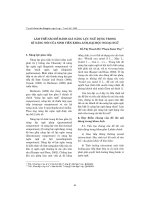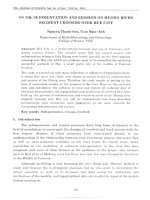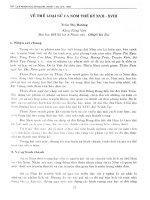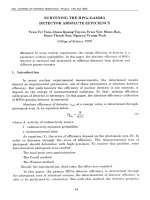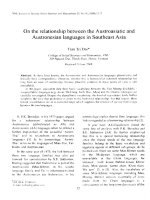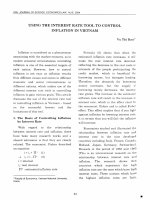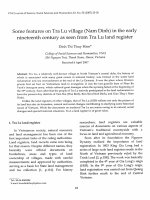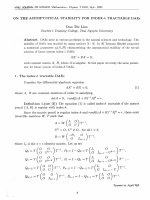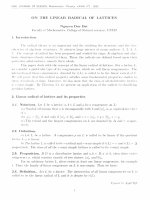DSpace at VNU: Using the interest rate tool to control inflation in Vietnam
Bạn đang xem bản rút gọn của tài liệu. Xem và tải ngay bản đầy đủ của tài liệu tại đây (4.41 MB, 10 trang )
VNU. JOURNAL OF SCIENCE, ECONOMICS-LAW, N01E, 2004
U SIN G THE IN TER EST RATE TOOL TO CONTROL
INFLATION IN VIETNAM
V u T h i D a u (*
Inflation is considered as a phenomenon
Form ula
(2) shows
th a t
when
the
associating w ith the m a rk e t economy, so in
estim ate d inflation r a te increases, it wil
modern economic circumstances, controlling
make
inflation is one of the essential ta rg e ts of
reflecting th e decrease in the real costs 01
each
in te re sts of the people participating the
nation.
However,
how
to control
th e
real
in te re st
credit
from different causes and occurs in different
borrowing money, b u t dam ages lending
economic
Therefore,
social
circum stances
in
which
the
is
decrease
inflation is not easy as inflation results
an d
m arket,
rate
beneficial
d e m an d s
money
different in te re st ra te tools in controlling
borrowm g money decreases, the interest
inflation to gain various goals. This article
ra te grows. The increase in the estim ated
discusses the use of the in te re st ra te tool
inflation r a te will re s u lt in the increase in
in controlling inflation in V ietnam - based
in te re st rate, which is th e effect cited bv
on
the economist, F ish e r an d is called Fisher
successful
lessons
and
the
but
th e
borrowing
different nations, which m akes use of the
the
increases,
for
for
supply
O-
•effect. This effect implies th a t if you fight
lim itations of this tool.
ag ain st inflation by lowering in terest ra tf,
1. The B asis o f C on trollin g Inflation
by In terest Rate
W ith
reg ard
to
th e
it is c ertain t h a t you will fail: the inflation
will increase.
relationship
Economists studied an d illustrated the
betw een in te re st ra te a nd inflation, there
relationship betw een inflation ra te and
have been m any research works and a
in te re st
sh a re d admission is th a t they are closely
countries including Italy, France, C anada,
related. The economist, F isher described
Holland, J a p a n ,
a n equation:
Brussels in th e period of 1982 and
ra te
in
th e
nine
developed
G erm any, Switzerland,
1983
i = ir + n * (1)
-> ir = i - n e (2)
relationship
i = in te re st
inflation.
The
ir: real in te re st
countries
which
n e : estim ated inflation ra te
inflation ra te are the ones which have hib'h
(This is an in te rn a tio n a l research on the
betw een
in te re st ra te
re sea rc h
shows
experience
the
and
th a t
hi£ib
in te re st rates. T h ree nation s which have
th e
n Faculty o f Economics, Vietnam National University,
Hanoi.
53
high est
inflation
ra te s
are
Italy 1
5
Vu Thi Dau
Fnce and C a n a d a a n d they are
tfee nations
th e
in te re s t
r a te
in
re a lity
is
considered as th e solution of m any nations,
lirtst rates; four n a tio n s w hich have low
including developing nations. Since 1983,
in to n
controlling
a re
have
of raisin g
highest
ra te
which
also
Japan,
G erm any,
the
in te r e s t
ra te
has
been
H aid and Sw itzerland, a n d they a re
po pu lar in L a tin A m erican co u n tries a n d it
a) he nation s which h av e low in te re st
h a s also become th e p rim a ry factor in the
ns
stabilization p ro g ra m m e s of K orea an d
ỈI brief, they a d m itte d in theory an d in
p:tce
th a t
th e
re la tio n sh ip
betw een
irn s t ra te a n d inflation is undeniable. It
isu basis for using th e in te re s t ra te tool
icoitrolling inflation in m any different
nois in modern economic circumstances.
T aiw an in th e m iddle of th e 1960s, and
Indonesia in 1986 a n d 1974. Some o th e r
n atio ns such as J a p a n , C h in a fell into
inflation in th e
century.
The
1990s of th e tw e n tie th
inflation
r a te
of
these
countries was a t th e m in u s level (Ja p an : 2 % / year, C hina: - 2.6 % / year). The
Tie Federal Reserve System of the
governm ents of th e se cou ntries h a d to use
Lt(d S ta te s of America (FED), to gether
many
W1 )ther tools, actively used th e in te re st
overcome
n t)ol in controlling inflation d urin g the
in te re st ra te (J a p a n im p le m e n te d th e zero
daces w hen
in te re s t rate, C h in a from 1996 to July,
th e
economy
faced
the
different
m e a s u re s
deflation,
ĨDhable situ a tio n of inflation rate. In th e
1997 seven tim es
y rso f 1979 and 1982, th e inflation ra te
rate).
and
tools
including
to
lowering
lowered th e
in te re st
(Anerica w as alw ays a t th e two digit
However, u sin g th e in te re s t r a te tool in
lek By raising th e discount ra te to a
hi evel in A m erica’s histo ry (10.5 % in
10 and 11.5 % in 1981), an d therefore,
t iiterest ra te a m o u n te d to 13.36 % in
19 and 16.38 % in 1981, did FED reduce
t ilflation r a te from 13.7 % in 1979 to
8 ° / in 1980 a n d 6.1 % in 1981, 1982. In
tn:e, a t th e end of 1978, th e economy
f
h b of France h a d to raise th e discount
rs o 17.5% a n d th e m a rk e t in te re st ra te
t'lf.28% - th e h ig h e st in te re s t ra te in
Fn:e’s history, in o rd e r to repel th e
iiaton.
W ithin only six m onths, th e
dxnnt ra te w as ra ised twice as m uch as
t t n 1980. The solution to th e problem
controlling inflation can n o t stay for a long
time. If the in c re ase in th e in te re s t ra te
lasts to fight a g a in s t th e inflation, it will
decrease in v e stm e n t, total d e m an d and
o u tp u t an d u n e m p lo y m e n t will rise. The
fact
in
th e
c o u n trie s
fighting
a g a in s t
inflation by u sin g th e se tools has proved
this.
W hen
A m erica
controlled
the
inflation a t the one digit level in 1980,
1981, th e price th e y h a d to pay w as the
regression of to ta l d e m a n d a n d outpu t, so
from th e end of 1982, Fed lowered the
in te re st ra te from 11.5 % in 1981 to 9.25 %
in 1982. The sam e situ a tio n h a p p en e d in
France,
fighting
a g a in s t
th e
two digit
inflation by ra isin g in te re s t rate, th e total
V N i l , Journal o f Science, Econom ic s -Im w , N()IE, 2004
U sing the interest rate tool to.
)
d em and decreased a t - 5% in November,
again m ade inflation continue to gr«wf
1981. T his implies t h a t using the in te re st
th e
ra te tool in controlling inflation can affect
considered
the
economic
increased by 2.2 tim es in 1980; 29.9 iis
ta rg e ts and th a t u s in g the in te re st ra te
in 1985; 131.1 tim es in 1986; 548 tir.ea
tool should be carefully considered.
1987.
im plem en tatio n
of oth er
Moreover, it is impossible to use the
in te re st ra te tool to overcome inflation in
any cases because inflation re su lts from
different causes. T he in te re s t ra te tool is
best used w hen the grow th of money is too
high; a t t h a t tim e ra is in g th e in te re st rate
will re s tra in inflation.
2. C o n trollin g In fla tio n by th e In terest
Rate Tool in V ietn a m
By 1981, inflation in V ietnam had not
salary in circulation
as
th e
in
1976 \3
survey
marker, t
The a m o u n t of money is s u d i
circulation w as so high th a t it mac? 0
prices of commodities increase constin.
In such high inflation, it was the firs te
th e S ta te of V ietnam raised the ques\ 0 )f
fighting
a g ain st
inflation.
T h en a*
inflation p ro gram m es were d ra w n ipi
many offices under different level d
branches. Thus, a t t h a t tim e th e re Via
renovation in th e view a n d w y if
acknow ledging inflation. From th e n ci,e
m e asu re s of fighting a g ain st inflation we
been adm itted, b u t th e retail prices of
defined,
commodities and services in th e m a rk e t
im p le m e n tin g
increased by 20 % per year. From 1981,
such as carry ing out the m a rk e t pe
inflation was at th e level of 69.6 % per
m echanism ,
year, b u t it was not a d m itte d in th e official
r ig h t s of e n te r p r is e s , re fo rm in g ecQGC
docum ents. The g o v e rn m e n t dealt w ith it
policies
in the aspects of “price, salary, money”,
financial a n d m on etary policies alo’d
mainly by a d m in is tra tiv e
using
m easures.
In
associating
th e
the
Especially,
tools
of
including
per y ear a n d afte r t h a t it re m a in e d a t the
controlling th e inflation.
placed
V ie tn am ’s
self-on>l
th e
in te re s t
ra te
refom)f
plies,
tol n
By 1989, in te re s t ra te h a d onl bn
considered as a tool to im plem e.t le
“galloping inflation” of high level. The two
reallocation of n a tio n a l income, decraan
digit inflation w e n t on un til 1995 (in 1995:
product
5.3 % / year). T hus, e n te rin g the economic
expenses. Because of such a point c vv
renovation,
the
in te re st ra te w as not considered a s I id
inflation which w as very high a n d lasted
of price and th u s it was not usedaan
m any years. Such a serious inflation level
economic tool. The in te re st r a te Dies
forced
d u rin g this tim e period
V ie tn am
S ta te
to
in
re n o a n
the
th e
economy
stQS>f
m onetary
1986, inflation re a ch e d the level of 747 %
th re e digit level for th re e years, which
th e
th e
economic
w idening
etc.
th e
with
confronted
issue
th e
money
prices,
and
r e tu rn
of hk
m ainly 18 a
continually in ord e r to m eet th e spending
political aim a n d content, describngic
re q u ire m e n ts of th e economy, and this
discriminatory tre a tm e n t between eonii(
V N u , Jo u rn a lJ)f Science, Econom ics-Law , N ()IE, 2004
V u Thi Dau
‘cors and u n its an d show ing th e s ta te ’s
th e
ikidization
in te re s t rate, m e an w h ile th ese clients used
to
th e
s ta te
enterprises,
capital issued
w ith
the subsidized
socially, it is the real in te re s t ra te th a t
capital
a ‘ minus,
com pensations for losses from the s ta te
th u s
th e
in te re s t
ra te
ineffectively,
req u irin g
the
'Scribed by the s ta te was alw ays lower
budget
a i zero for a long time. W ith such
overspending of the s t a t e ’s budget. In tu rn ,
te est
th e budget o v e rsp en d in g requ ired to be
ra te
policies,
in te re s t
ra te
Ofcened inflation.
and
c o n trib u tin g
to
the
solved by issuing money. Therefore, the
?irst, in te re st ra te did not encourage
e saving in th e economy. In 1993, if a
volume of currency in circulation increased
rapidly.
ie*t kept 1000 VND in th e bank, the
The renovation in th e condition th a t
^ le of th a t sum of money would be
th e economy fell in to serious economic
[Uvalent to about 700 VND; similarly, in
crisis, inflation w as v ery high an d the
it
would
be
eq u iv alen t
to
only
’O/ND. W ith low income, th e households
financial
m ade
m a rk e t
w as
objective
underdeveloped,
re q u ire m e n ts
for
'i^ tn a m only had a very little am o u n t
reno vating
Sivings, they couldn’t allow th a t sum of
tra n s fe rrin g the one level b anking system
01ey to devalue w hen keeping it in the
(built in 1951) to th e two level banking
so they often used th a t a m o u n t of
system. W hen Decree No.53 (March, 1988)
the
b a n k in g
system,
01ey to buy commodities, gold and h a rd
was
rfcncies.
renovation model of th e banking system,
As
iwiodities
a
of
re su lt,
th e
different
prices
kinds
of
were
oving and inflation was worsened.
tecond,
n
th e
th e
In
m in us
in te re s t
capital
th e
ra te
th a t
mnodities were scarce a n d commodity
1C-S
increased
ptcially
s ta te
strongly,
e n te rp ris e s
enterprises,
ru sh e d
C entral
to g e th e r
B an k
with
d eterm ined
the
and
im plem ented m o n e ta ry policies, including
borrowing
condition
th e
prom ulgated,
to
ro w capital from the b a n k s to m ain ta in
ei‘ production an d b u sin ess operations
d t h e n stored commodities, w aiting for
e lig h e r prices in o rder to get benefits. It
*(e th e capital scarcer a n d th e prices of
m n o d ities continued increasing.
laying down as a policy th e surplus real
interest rate and considering the interest
ra te as an im p o rta n t tool of the m onetary
policy. At th a t tim e in te re s t ra te consisted
of two kinds: Subsidized in te re st ra te an d
agreed
in te re st
in te re st
r a te
ra te .
fa c ilitated
The
subsidized
enterprises
to
change d ram atically into operation in the
m a rk e t m echanism . T he agreed interest
ra te consisted of th e ag re ed in terest ra te of
th e
specialized
banks
an d
the
agreed
interest rate of the non-state organizations.
This a w a re n e ss re n o v a tio n of in terest ra te
nh ird , b a n k s m ainly loaned th e sta te
w as significant to control the economy in
n economy an d the collective economy
th e m a rk e t m ech anism , im plem ented in
VNU. Journal o f Science, EconomicS-Luw, N„IE, 2004
Using the interest rate tool to.
Vietnam. The in te re s t ra te w as initially
The competition of th e u n its which da
reg arded as price of currency and w as
gradually d e te rm in e d by th e m arket, th u s,
with money p ushed th e in te re st rate 0
hig h er level. The in te re s t ra te apple* 1
it m anifested a signal in V ie tn a m ’s credit
reality w as too high, exceeded the caoait
market.
of the m arket and caused the Ciptc
borrowing clients’ stron g reaction. At h
end of 1988, b a n k s h a d to reject the zg?e
lending. From M arch in 1989 -h
governm ent decided to change the inteet
ra te policy fu n d a m e n tally an d accorii g’
th e re was a difference betweer th
effective in te re st ra te and the estinite
in te re st rate. It is e stim a te d th a t intee:
ra te consisted of th e basic interest at
plus the inflation rate. Detective N 0 .&5 T
dated M arch 13, 1989 of the Counc
M inisters assigned th e Governor of tl
S ta te B ank of V ietnam the right
d eterm in e th e loan in te re st rate ư
ad ju st it to th e fluctuation of mak
prices. This was a new progress in tl
a w are n e ss of in te re s t ra te in Victrii
which allowed to use th e in te re st ra'^et-o
more effectively. T hus, in te re st rate Ml
regard ed as a criterion th a t needed t> 1
reckoned, im p lem ented an d laid ov
more actively. Decision No.39 /
d ated on April 10, 1989 set up the
b a n k ’s fu n d a m e n ta l principles of Oi
in te re st ra te an d deposit in te re st rat*
In
reality
from
J u ly
in
1987
to
F e b ru a ry in 1989, th e in te re s t ra te w as
adjusted twice in th e direction of lessening
subsidization d ra m a tic a lly th ro u g h credit
and inflation factor. The G overnor director
of the S ta te B an k s tip u la te d th e agreed
in te re st
r a te
b ased
on
two
principles:
agreed loan in te re s t ra te w as equal to th e
highest deposit in te re s t r a te (at t h a t tim e
it was 8%) plus ad d itio n a l b a n k charge (at
th a t tim e w as 0.3 -
0.4 %), th u s th e
in te re st ra te s increased rem ark ab ly . This
in te re st ra te policy played an active role,
avoiding
ad van tag e
the
of
s titu a tio n
b a n k ’s
of
capital
ta k in g
to
store
commodities and w aiting for profits when
the price of th e m increases, and freeding
billions of com m odity money considered
stag n a n t.
en terp rises
This
to
policy
consider
also
pluses
made
an d
minuses, revoke capital an d increase the
circle of capital. Therefore, the price index
dropped to 7.2 % p e r m onth in the last six
m onths of 1988 a n d 5 % per m o nth in the
first six m on th s of 1998.
Moreover, com m ercial b a n k s dealt w ith
in te re st ra te u n m eth o d ically and raised
follows:
1) The in te re s t ra te m u st be enouih
preserve the capital a n d profit.
higher th a n the guided one. In particular,
2) A u n ite d in te re s t is applie*
economic sectors a n d ad justed to t
the guided in te re s t ra te of the state b an k
fluctuation of m a rk e t prices.
the in te re s t r a te to th e level th a t was
on J u n e 6th, 1988 was 8.3 %, b u t some
ban k s im p le m e n te d with th e level of 8.4 %,
commonly with 9 - 10 % a n d even 11- 12%.
V N u , Journal o f Science, Economic S-Lxiw, N J E , 2004
3) All th e sources of capital mobiiz
by b a n k s for loan get in te re s t an d
V u Thi Dau
ln° ư t of money loaned by b a n k s is paid
in the ban k s for safe a n d steady profits.
n e > e i:t.
The
*9 The difference betw een the loan
n e)e^t r a te and th e in te re st ra te
sa'iiigg on average is 0.5 % per month.
of
U nited
M onetary
N ations,
Fund
appreciated
inflation.
th e
and
V ie tn a m ’s
The
In te rn a tio n a l
World
fight
developm ent
B ank
a g ain st
pro g ram m e
report of th e U nited N ations in December,
*) The stru c tu re of th e in te re st ra te of
’S/Digg an(j th e loan in te re s t ra te consists
basic in te re st r a te a n d th e index of
ủ n ịa jre in m a rk e t prices.
•phe
principles
above
were
1989 stated: The m e asu re s to stabilize
finance
and
money
ta k e n
by
the
governm ent of V ietnam in fighting again st
inflation were re m a rk a b ly successful in
1989. In fact, to control inflation w as the
npieifiented, from th e situ a tio n t h a t th e
resu lt of im plem entin g
nniis in te re s t ra te s la ste d for m any years,
m easures and tools in controlling inflation,
k
of which the effective contribution of the
in te re st ra te s
ifectiye
ones
in
becam e
1989.
ne>e$t
ra te s
w ere
nlation
ra te
(from
th e
su rplus
Moreover,
ad ju sted
the
to
th e
M arch, 1989
m any
different
in te re st ra te tool w as prim ary.
In
1989,
m a rk e t
prices
grew
on
to
average by 2.5 % / m o nth (15% / m onth in
<(D1U'iry, 1990 th e re w ere five tim es to
1988), th e inflation was reduced from the
ia u 3t th e in te re st rates). The policy of
three digit level in 1986, 1987 and 1988 to
;u’Plus effective in te re st rates, applied in
the level of 34.7 % in 1989 and th e two
a t th a t time, w as significant in
digit level of inflation rem ain ed u n til 1995
>oh theory a n d practice, w hich expressed
in th e direction of b e tte rin g the high ra te
hi Hew a w a re n e ss of th e in te re st rate: the
of inflation (14.4 % in 1994, 12.7 % in
nehegt ra te is not only a simple economic
1995).
ra ’i«‘ible b u t also a tool to fight a g ain st th e
However, th e policy of s u rp lu s effective
nlation effectively.
in te re st ra te w as absolutely im plem ented
^ihce then, th e inflation in V ietnam
only in 1992 because in 1990, 1991, the
ia5 been identified as re s u ltin g from m any
h a pp enin g
liferent
complicated, which m ade th e a d ju stm e n t
causes,
of w hich
th e
most
of
inflation
w as
too
;1£ntfic a n t factor is m onetary. R aising th e
of in te re st ra te impossible to catch up with
newest r a te of savings over th e inflation
the situation. It showed t h a t the flexible
ae
was considered as a fu n d a m e n tal
application of th e in te re st ra te policy was
ntasvire of th e a n ti-in flatio n m e asu re s in
not easy, which made th e in te re st rate
h s Period. The s u rp lu s a n d high deposit
u n su itab le to the fluctuation of inflation.
n e i'est ra te en su red th e money property
* th e
public,
which
m ade
th e
new
ir?Unistance emerge: In s te a d of storing
oruttodities, th e people k e p t th e ir money
In general, V ie tn a m ’s inflation control
before 1986 (mainly the fight ag ain st high
inflation) created good conditions for th e
VNU, Journal o f Science, Economics-Law', N„IE, 2004
Using the interest rate tool to.
economy to g am im p o rta n t achievem ents:
price index grew by 0.8 %. Although the
GDP w as twice as much as t h a t before the
consum er price index in 2001 w as ii>hei
renovation,
the
th a n th a t in 2000, th e economy w as stil ir
crisis, commodities becam e plentiful and
deflation a n d the economic growth d d n i
diversified, m ate ria l and sp iritu a l life of
reach th e ta rg e t of 7.5 % p er yea
the people was gradually improved.
proposed by th e N ational Assembly C-t )nb
From
re m a in ed
th e
economy
overcam e
1996, th e price index always
at
one
digit
level,
but
the
ae
reached 6.8 % per year).
W hen
analyzing
th e
causes
<’f th*
situ atio n became complicated: th e price
deflation, opinions were varied. ],,u 11
index of 1996, 1997 w as 4.5 % a n d 3.6 %,
brief, th e deflation re su lted from econ^nii
1998, 9.2 %; 2000, - 0.6 %; 1999 and 2001,
m echanism and stru c tu re , low a n d v.nivei
0.1 % a n d 0.8 %. T h a t situ a tio n placed
incom e
V ietnam
strong
in v e stm en t and fluctuation in th e vorl
deflation. If in 1996 the deflation lasted
m arket. In 1997, th e s ta te p u t fpr^ar
four m onths (from May to A ugust) w ith the
four groups
total deflation ra te of 1.6 %, in 1999, the
d em and in th e economy. In 1999, Ifi^rke
deflation continually lasted e igh t m onths
prices tend ed to fall down sharply,
(from M arch to October) w ith the total
th e g o vernm en t’s Resolution 08/ 19í*9 Q
deflation ra te of 4.4 %. In 2000, deflation
-C P
w as more complicated; how ever, it lasted
solutions to fighting a g a in s t deflation-
in a long lasting a n d
five m on ths (from M arch to July) with the
total deflation ra te of 3.4 % - no t as much
as
th a t
in
1999, b u t it showed
more
seriousness because th e price level in the
first m onths of 2000 w as not a s high as
t h a t in th e sam e period of 1999 (2 % as
com pared with 3.6 %). T h a t s itu a tio n led
to the general price base of th e economy in
2000, which w as much lower th a n th a t in
1999 (- 1.6 % as com pared w ith + 0.1 %). In
2001, due to the g ov e rn m e n t’s m e asu re of
s tim u la tin g d em an d to aim a t overcoming
deflation (im plem enting th e no-more- th a n
- 5 % inflation objective proposed by the
N atio n al Assembly), th e economy couldn’t
overcome
lasted
this
th re e
situation:
m onths
th e
deflation
successively (from
M arch to J u n e) a n d in 2001, th e consum er
VNU. Journal o f Science, Econom ic S - L u w
,
N„J E. 2004
of
th e
of
public,
solution
continued
to
ineffe'tiv
stim u la te th
bringing
ou t
^eve
Of th e solutions above, th e s ta te use
th e loosened m o n etary policy a n d active
renovated th e in te re st ra te policy ÌI’ ^
direction of liberalization to improve tỉ
situation. The in te re st ra te policy v.nd<
th is direction loosened th e interference
the C en tral Bank a n d th e liberalization
in te re st ra te was g rad ually im p leinant(
th ro u g h
m any
steps.
From
1996.
tl
in te re st ra te w as out of control u n d e r tl
in te re st ra te m a xim u m to g e th e r with t]
c o n stra in t
of
the
average
differen
betw een th e loan in te re st ra te an
basic in te re st rate. Sinca J u n e - 200-> t
in te re st ra te h a s been liberalized. l n t
im ple m e n ta tio n of this in te re s t r a t e I)0^1(
60
V u Thi Dau
to use the in te re st ra te tool aim ing a t
increase originated from m any different
overcoming the deflation, th e in te re st ra te
causes
was continuously ad ju sted to stim u la te the
fluctuation of prices in th e world m a rk e t
investm ent and consum ption dem and. The
1997, and five tim es in 1995. T he repeated
(petrol price and gold price in the world
grew high continuously), the in crease in
th e im port price of nitrogen, th e increase
in steel price, and th e bird flu epidemic in
our country and in some others. The
interest
years
situation above hap pen ed while th e whole
aiming a t stopping th e deflation didn’t
country made a n effort to im p le m e n t the
gain the re s u lt as expected, th e deflation
objective of high a n d solid economic growth
continued to get worse in th e years of 2000
in the period of 2001 and 2005, which
a n d 2001 (the price index in 2000 was —
posed a difficult question for th e economic
0.6 % and in 2001 w as 0.8 %). It showed
policy m akers. The S ta te B an k of V ietnam
th a t w hen in v e stm e n t w as ineffective and
advocated m a in ta in in g th e basic in te re st
consum ption was not sensitive to in te re st
ra te a t 0.625 % per m onth, a im in g at
rate, lowering in te re st r a te w a s n ’t effective
reaching th e norm of economic grow th of
enough to s tim u la te th e d em and . In 2002
2004, which is 7.5 % - 8%. However, the
a n d 2003, the deflation ra te decreased, th e
in te re st ra te s in th e m a rk e t te n d ed to
norm of no more th a n 4% inflation as
grow slightly, especially m edium a n d long
proposed by th e N ation al A ssembly w as
term in te re st rates.
deflation lasted for a long tim e, so the
C entral B ank continuously reduced the
interest rate: four tim es in 1996, twice in
ra te
fulfilled due
lowering
to
the
in
th e se
im p lem en tatio n
of
various com prehensive solutions.
such
as
th e
influence
of
the
It is possible to find t h a t the inflation
which h a s occurred since th e beginning of
The situ atio n becam e more unsolvable
w hen from th e beginning of 2004, inflation
2004
is
m ainly
due
to
th e
p ush
of
exp end iture and th e increase in th e price
tend ed to grow. According to th e figures of
of production factors, th u s th e m e asu re s of
th e
B ureau of S tatistics, pa rtic u la rly in
curbing inflation have to aim a t controlling
February, 2004, th e index of price increase
the prices of in p u t commodities. W h atev er
in the m a rk e t w as 3 % (equal to the level
the causes are, to overcome inflation, it is
of price increase of th e whole y e a r 2003).
n ecessary to a d ju st th e in te re st r a te to th e
G enerally calculating,
relationship betw een supply and d em an d
in
th e
first two
m onths, it increased by 4.1 %, th is h a s
for capital in th e m arket.
b e en the h ig h e st level of price increase of
3. L esso n s from E x p erien ce
th e first two m on ths over th e p a st ten
years. If we calculated eight m o n th s of the
T hrough
th e
reality
of u sing
th e
y e a r 2004, th e level of price increase was
in te re st ra te tool in controlling inflation in
8.3 %, exceeding th e pla n n ed norm of the
oth er countries and
w hole year of 2004. The s itu a tio n of price
lessons are d raw n from experiences as
in V ietnam , some
follows:
V N U , Journal o f Science, Econom ic S ' Law, N 0JE, 2004
Using the interest rate tool to.
61
First, inflation re s u lts from various
Third, in te re st ra te is one of the tools
causes, so it is impossible to use in te re st
of economic
ra te in all cases as a tool to achieve the
m on etary policy in particu lar; therefore,
goal as expected.
w h en
Second, in te re s t ra te is a special kind
of price, th u s w h en used as th e tool in
controlling inflation, it should be carefully
used
necessary
policy
to
to
in
general
and
of
control
inflation,
it
is
combine
different
tools
to g eth er to get th e b e st result.
Fourth,
w hen
inflation
becomes
and fully considered. The d e term in a tio n of
complex,
in te re st ra te in each na tio n is different,
carefully used in ord er to achieve the
but the common tendency in the m a rk e t
defined economic ta rg e ts (do not allow the
economy is to liberalize th e in te re st ra te
in te re s t ra te to be a n obstacle to the
when necessary.
im p le m e n ta tio n of o th e r objectives).
th e
in te re s t
ra te
should
be
REFERENCES
1.
Lê Vinh Danh, Chính sách tiền tệ và sự điều tiết vĩ mô của N gàn hàng trung ương ớ các
nước tư bản p h á t triền.
2.
Fredric s. Mishkin, Tiền tệ-Ngản hàng và thị trường tài ch ín h , NXB Khoa học Kỷ th u ật, Hà
Nội, 1994.
3.
Ngân hàng Nhà nước Việt Nam, Ngân hàng Việt N am , quá trình xây dựng và p h á t triẽn ,
NXB Chính trị Quồc gia, Hà Nội, 1996.
4.
Ngân hàng Nhà nước Việt Nam, Báo cáo thường niên các năm từ 1996 - 2003.
5.
Ngân hàng Nhà nước Việt Nam, Báo cáo chính sách lãi suất ở Việt N a m (Bản sô 1), tháng
11 - 2002 .
6.
Ngân hàng Nhà nưốc Việt Nam, Tài liệu hội thảo “J3àn về cho vay theo lãi suất thoả thuận
bằng đồng Việt N a m ”, Hà Nội, 2002.
7.
Nguyễn Minh Phong, L ý thuyết lạm phát, giả m p h á t và thực tiễn ở Việt N a m , NXB Chính
trị Quốc gia, Hà Nội, 2000.
8.
Thời báo kinh tế Việt Nam, K inh tế V iệ t N am và Thê giới'. 2000 - 2001, 2001 - 2002, 2002 2003, 2003 -2004.
9.
Viện tiền tệ tín dụng, Ngân hàng Nhà nước Việt Nam, Thông tin chuyên để lãi suảt ngàn
hàng tập 1, tập 2, 1991.
V NU, Journal o f Science. Ecotiom ics-Luw, N„IE, 2004
V u Thi Dau
62
TAP CHÍ KHOA HỌC ĐHQGHN, KINH TẾ - LUẢT, s ố 1E, 2004
SỬ DỤNG CỒNG CỤ LÃI SUAT TRONG KIEM s o á t l ạ m p h á t
ở VIỆT NAM
Vũ Thị D ậu
K hoa K in h tê\ Đ ại học Quốc g ia H à N ội
Kiểm soát lạm p h á t là một tro n g n h ữ n g mục tiêu q u a n trọng n h ấ t của mỗi nước. Để đạt
được mục tiêu này, mỗi nưốc ph ả i sử dụng n h iề u biện pháp và công cụ k hác n h a u . Một
trong những công cụ kiểm soát lạm p h á t phổ biến n h ấ t là công cụ lãi suất. Trong thực tế, sử
d ụng công cụ n ày đã m ang lại bài học th à n h công cho nh iều nước.
Việt Nam là một quốc gia đã th à n h công tro n g việc đẩy lùi lạm p h á t ba con sô' b ằ n g các
sử dụng công cụ lãi s u ấ t vào cuối th ậ p kỷ 80 của th ế kỉ 20. Bằng cách thực hiện d ẩ n dần
công cụ này, từ 1986 đến này, lạm p h á t được kiểm soát ở mức một con sô".
Tuy nhiên, sử dụ n g công cụ lãi s u ấ t có hiệu quả vì mục tiêu kiểm soát lạm p h át, hiện
nay còn nhiều vấn đề cần phải giải quyết: từ b ả n th â n việc thực hiện công cụ lãi s u ấ t tới
việc thực hiện nó và k ế t hợp với các công cụ và biện ph áp khác.
V N i f , Journal o f Science, Econom ics-Luw\ NnIE, 2004
